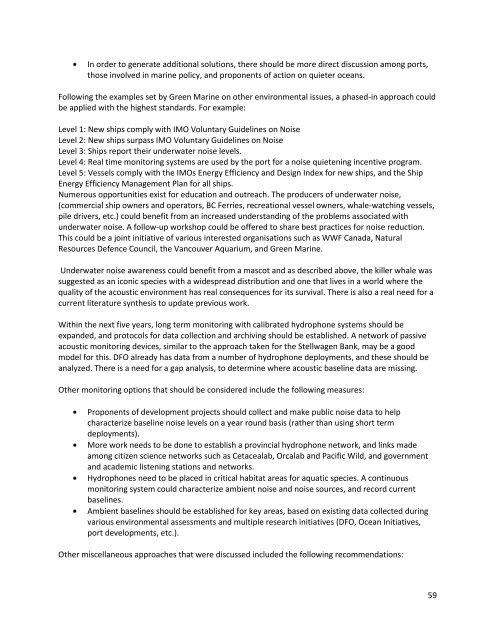mcbem-2014-01-submission-wwf-en
mcbem-2014-01-submission-wwf-en
mcbem-2014-01-submission-wwf-en
Create successful ePaper yourself
Turn your PDF publications into a flip-book with our unique Google optimized e-Paper software.
In order to g<strong>en</strong>erate additional solutions, there should be more direct discussion among ports,<br />
those involved in marine policy, and propon<strong>en</strong>ts of action on quieter oceans.<br />
Following the examples set by Gre<strong>en</strong> Marine on other <strong>en</strong>vironm<strong>en</strong>tal issues, a phased-in approach could<br />
be applied with the highest standards. For example:<br />
Level 1: New ships comply with IMO Voluntary Guidelines on Noise<br />
Level 2: New ships surpass IMO Voluntary Guidelines on Noise<br />
Level 3: Ships report their underwater noise levels.<br />
Level 4: Real time monitoring systems are used by the port for a noise quiet<strong>en</strong>ing inc<strong>en</strong>tive program.<br />
Level 5: Vessels comply with the IMOs Energy Effici<strong>en</strong>cy and Design Index for new ships, and the Ship<br />
Energy Effici<strong>en</strong>cy Managem<strong>en</strong>t Plan for all ships.<br />
Numerous opportunities exist for education and outreach. The producers of underwater noise,<br />
(commercial ship owners and operators, BC Ferries, recreational vessel owners, whale-watching vessels,<br />
pile drivers, etc.) could b<strong>en</strong>efit from an increased understanding of the problems associated with<br />
underwater noise. A follow-up workshop could be offered to share best practices for noise reduction.<br />
This could be a joint initiative of various interested organisations such as WWF Canada, Natural<br />
Resources Def<strong>en</strong>ce Council, the Vancouver Aquarium, and Gre<strong>en</strong> Marine.<br />
Underwater noise awar<strong>en</strong>ess could b<strong>en</strong>efit from a mascot and as described above, the killer whale was<br />
suggested as an iconic species with a widespread distribution and one that lives in a world where the<br />
quality of the acoustic <strong>en</strong>vironm<strong>en</strong>t has real consequ<strong>en</strong>ces for its survival. There is also a real need for a<br />
curr<strong>en</strong>t literature synthesis to update previous work.<br />
Within the next five years, long term monitoring with calibrated hydrophone systems should be<br />
expanded, and protocols for data collection and archiving should be established. A network of passive<br />
acoustic monitoring devices, similar to the approach tak<strong>en</strong> for the Stellwag<strong>en</strong> Bank, may be a good<br />
model for this. DFO already has data from a number of hydrophone deploym<strong>en</strong>ts, and these should be<br />
analyzed. There is a need for a gap analysis, to determine where acoustic baseline data are missing.<br />
Other monitoring options that should be considered include the following measures:<br />
Propon<strong>en</strong>ts of developm<strong>en</strong>t projects should collect and make public noise data to help<br />
characterize baseline noise levels on a year round basis (rather than using short term<br />
deploym<strong>en</strong>ts).<br />
More work needs to be done to establish a provincial hydrophone network, and links made<br />
among citiz<strong>en</strong> sci<strong>en</strong>ce networks such as Cetacealab, Orcalab and Pacific Wild, and governm<strong>en</strong>t<br />
and academic list<strong>en</strong>ing stations and networks.<br />
Hydrophones need to be placed in critical habitat areas for aquatic species. A continuous<br />
monitoring system could characterize ambi<strong>en</strong>t noise and noise sources, and record curr<strong>en</strong>t<br />
baselines.<br />
Ambi<strong>en</strong>t baselines should be established for key areas, based on existing data collected during<br />
various <strong>en</strong>vironm<strong>en</strong>tal assessm<strong>en</strong>ts and multiple research initiatives (DFO, Ocean Initiatives,<br />
port developm<strong>en</strong>ts, etc.).<br />
Other miscellaneous approaches that were discussed included the following recomm<strong>en</strong>dations:<br />
59


